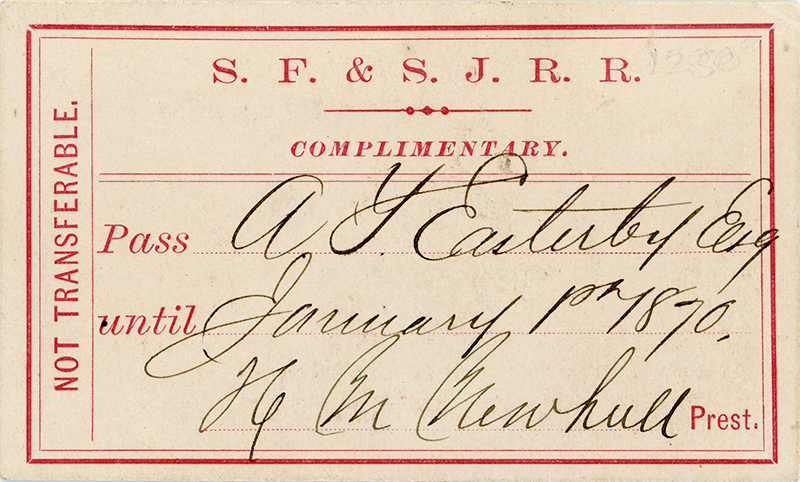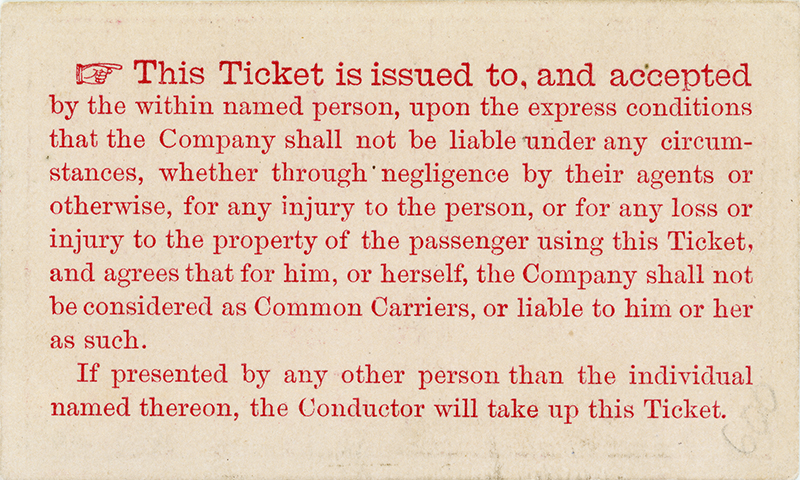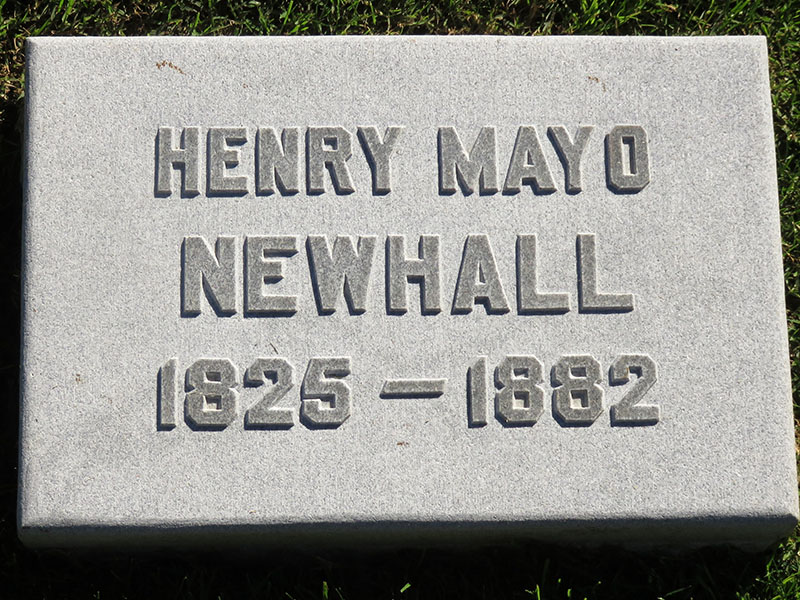|
|


Click image to enlarge
| Download archival scan
Non-transferable complimentary pass for free rides on Henry Mayo Newhall's railroad, the San Francisco & San Jose Railroad, valid until January 1, 1870. Filled out and signed in fountain pen by Henry Mayo Newhall, president. Off-white card stock, business card size, 3¼x2 inches, n.d. (1860s). Compare to this printed copy of Newhall's signature. Given the similiaries between this original example and the printed copy, we must question the authenticity of this other example of Newhall's signature on another S.F.&S.J.R.R. document; perhaps someone signed for him. Back of voucher reads:
This Ticket is issued to, and accepted by the within named person, upon the express conditions that the Company shall not be liable under any circumstances, whether through negligence by their agents or otherwise, for any injury to the person, or for any loss or injury to the property of the passenger using this Ticket, and agrees that for him, or herself, the Company shall not be considered as Common Carriers, or liable to him or her as such. If presented by any other person than the individual named thereon, the Conductor will take up [confiscate] this Ticket. Newhall issued this voucher to Anthony Y. Easterby, who in the 1860s was a prominent merchant in Napa and in 1864 co-founded the Napa Valley Railroad, which completed its line from Soscol to Napa City in 1865. ("History of Napa and Lake Counties" by Lyman L. Palmer, 1881.) In the early 1870s, Easterby was farming in the San Joaquin Valley when Leland Stanford observed his property and thought it a suitable place for train station and town. They called it Fresno. From the Society of California Pioneers:
Captain Anthony Y. Easterby was born in Surrey, England in 1818. At the age of 14, he set out to sea, visiting the Mediterranean, Chile and Panama before arriving in California in 1848. While in California, Captain Easterby set up several businesses in San Francisco, Sonoma, Fresno and Napa City. He married Emily Gray, sister of his business partner Francis Gray, in San Francisco on November 5, 1853. Mr. Easterby was involved in the founding of the Fresno Canal and Irrigation Company in 1871, and was also the President of the Napa Valley Railroad, as well as a member of the Masonic Order, Knights of Templar, and Knights of Malta. He died in Napa, California in June of 1893.
Most SCV residents would associate Henry Mayo Newhall with the town he founded on the Rancho San Francisco in the Santa Clarita Valley in 1876. They may not know, however, that Mr. Newhall considered San Francisco his primary home, and in fact spent much of the last half of his life in the Golden Gate city. Although arriving in the Bay Area with literally the clothes on his back during the California Gold Rush, he became a wealthy and prominent citizen of San Francisco through his auction, railroad, and real estate endeavors. In the late 1850s, most of the Bay Area's growth was heading south towards San Jose. Commuters between San Francisco and San Jose had to endure a grueling nine hour stagecoach trip. San Francisco's business leaders began to think about building a railroad between the two cities. Newhall was to become involved in the railroad business after receiving a one-third interest in a railroad company as a consolation prize for having co-signed and paid off a $90,000 note that went into default. Along with partner Peter Donahue, Newhall embarked on a risky venture which would become the San Francisco and San Jose Railroad. He eventually took the post of President of the Railway. Against all odds, and with construction costs exceeding a then enormous sum of $2 million, the tracks between San Francisco and San Jose were to be completed on January 11, 1864. Newhall sponsored a huge celebration that day which included a military parade in San Francisco and free train rides between the two cities. Newhall and Donahue are credited with planning and constructing the first financially successful railroad in California. However, Newhall had even loftier goals in mind. Since the early 1850s, the U.S. Government had been exploring potential routes for a transcontinental railroad to connect the East and West coasts and bring the wagon train era to a close. Newhall wanted to obtain the government contract to build the Western portion of the transcontinental railroad. But the usually successful Newhall met his match when he had to compete against the "Big Four" men of the Central Pacific Railroad. Collis P. Huntington, Mark Hopkins, Leland Stanford, and Charles Crocker would offer Newhall the right to build the last 175 miles of track from Sacramento to San Francisco in exchange for his promise not to interfere with the Central Pacific's lobbying efforts in the Congress. But when the Pacific Railroad Act awarded the contract to the Central Pacific in 1861, the wily Big Four managed to omit Newhall from the last draft. The transcontinental railroad would be completed at Promontory Summit, Utah, on May 10, 1869. Having been pushed aside by the Central Pacific, Newhall decided to try to build another railroad south to San Diego and than eastward through the Southwest. William Ralston, then President of the Bank of California, joined the Board of the SF & SJ Railway, and the two men began planning Newhall's dream to develop another transcontinental line to the South. But once again Newhall was to have his plans dashed by the Big Four. After completing the Central Pacific Railroad, the railroad magnates formed the Southern Pacific Railway and began buying up over one hundred small independent lines in California. They outmaneuvered Newhall by buying stock in the SF & SJ from the city of San Francisco. Knowing he would eventually lose to them again, Newhall sold his railroad to the Southern Pacific in October, 1870. Out of respect for their formidable rival and as part of the deal for purchasing his railroad, the next year the Southern Pacific accepted Henry Mayo Newhall on their Board Of Directors, a position he held the rest of his life. — Alan Pollack
LW3583: 9600 dpi jpeg from original voucher purchased 2019 by Leon Worden from a scripophily collector/dealer in Sausalito.
|
H.M.N. CATEGORIES:
Documentary: Story of Henry Mayo Newhall & Newhall Foundation (2015)
Portrait x2
HMN Signature on SF&SJRR Pass, <1870
HMN's Railroad Receipts (2)
5 Sons 1873
Obituary 1882
Reading of Will 1882
Graves of HMN & Heirs, Wyatt Earp, more
Son H.G. Newhall's California Bank
Grandsons George A., Walter Scott 1912
Grandson Almer Calls Argentina 1930
|
The site owner makes no assertions as to ownership of any original copyrights to digitized images. However, these images are intended for Personal or Research use only. Any other kind of use, including but not limited to commercial or scholarly publication in any medium or format, public exhibition, or use online or in a web site, may be subject to additional restrictions including but not limited to the copyrights held by parties other than the site owner. USERS ARE SOLELY RESPONSIBLE for determining the existence of such rights and for obtaining any permissions and/or paying associated fees necessary for the proposed use.











